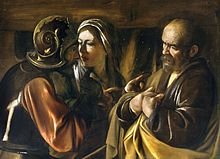Cantiones sacrae (Schütz)
The general title Cantiones sacrae was common at the time and was used by many composers, including Palestrina, Byrd and Tallis (1589 and 1591) and Hans Leo Hassler (1591).[6] In his foreword, he notes that the publisher "wrested" (extorsit) the accompaniment from him, while he regarded a bassus ad organum as "vain and clumsy" (vanum atq[ue] inconcinnum).[6] The composer has been described as "universal" (katholikos), and Cantiones sacrae as his "opus ecclesiasticum primum" (first sacred work), also his first publication on Latin texts.Musicologist Volckmar-Wasch identifies the 13th piece, Heu mihi Domine, as especially sad (tristis) and the 29th, Cantate Domino (Sing to the Lord), as happy (laetus).[6] Musicologist Stephen Rose terms the Cantiones "the composer's "most impassioned pieces" and notes: "They set first-person devotional texts to avant-garde madrigalism", evoking the crucifixion by extreme harmonies and "joy in Christ by dance rhythms".Craig Smith notes: "In richness of harmony, intensity of expression, and most importantly, the exploration of the vague, the ambiguous, and the contradictory, they are without equal," and compares them to the drama, light and shade in paintings by Caravaggio.[6] A sequence of three more Passion motets is positioned in the middele of the collection, beginning with Aspice pater piissimum filium (Consider, Father, your most pious son).

Heinrich SchützSacred vocal musicAndreas MusculusHans Ulrich von EggenbergFreibergbasso continuoSchütz-Werke-VerzeichnisHans Leo HasslerThirty Years' WarJohann Georg IpsalmsSong of SongsBernard of ClairvauxAnselm of Canterburya cappellabasso seguenteFerdinand of HabsburgmotetsmadrigalsLord's PrayerEmmanuel MusicMatteo MessoriKing JamespolyphonycounterpointThomaskantorJohann Hermann ScheinmadrigalismcrucifixionDenial of PeterCaravaggioMetropolitan Museum of ArtPassionPsalm 115Craig SmithGeistliche ChormusikGiovanni GabrieliAnna Amalie AbertBreitkopf & HärtelPhilipp SpittaArnold ScheringHeinrich SpittaBärenreiterCarus-VerlagHochschule für Musik DresdenDresdner KammerchorLudger RémyHans-Christoph RademannAllmusicWerner BreigMusic Library AssociationMessori, MatteoBrilliant ClassicsBreig, WernerDie MusikforschungGesellschaft für MusikforschungWolfram SteudeEarly MusicOxford University PressSmith, CraigInternational Music Score Library ProjectCompositionsMagnificatChrist ist erstandenPsalmen DavidsWeib, was weinest duDafne (Opitz-Schütz)Becker PsalterMusikalische ExequienDie sieben Worte Jesu Christi am KreuzChristmas StoryHeinrich Schütz House, Bad KöstritzHeinrich Schütz House, WeißenfelsNeue Schütz-AusgabeChorale monodyLutheran orthodoxyList of compositions